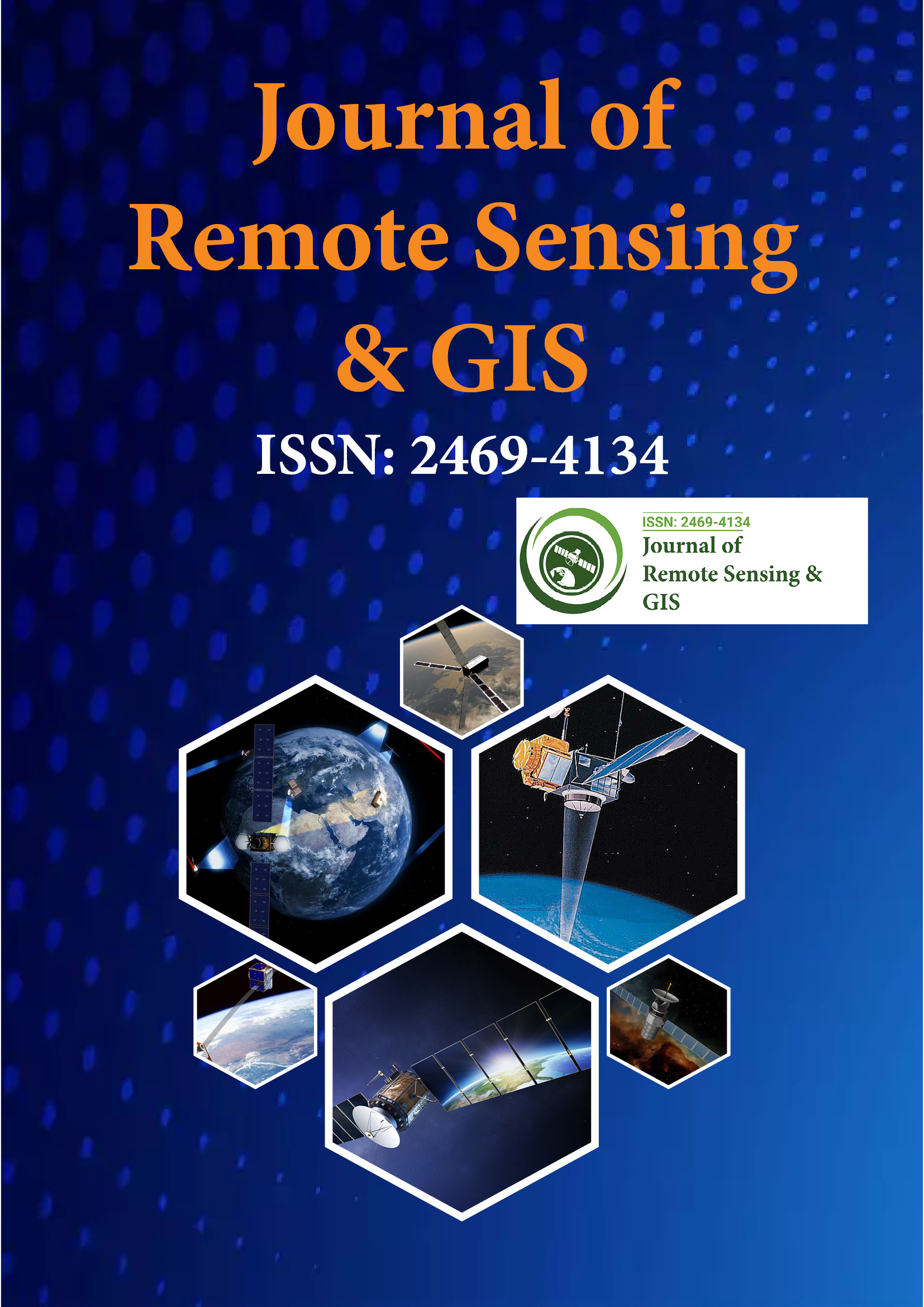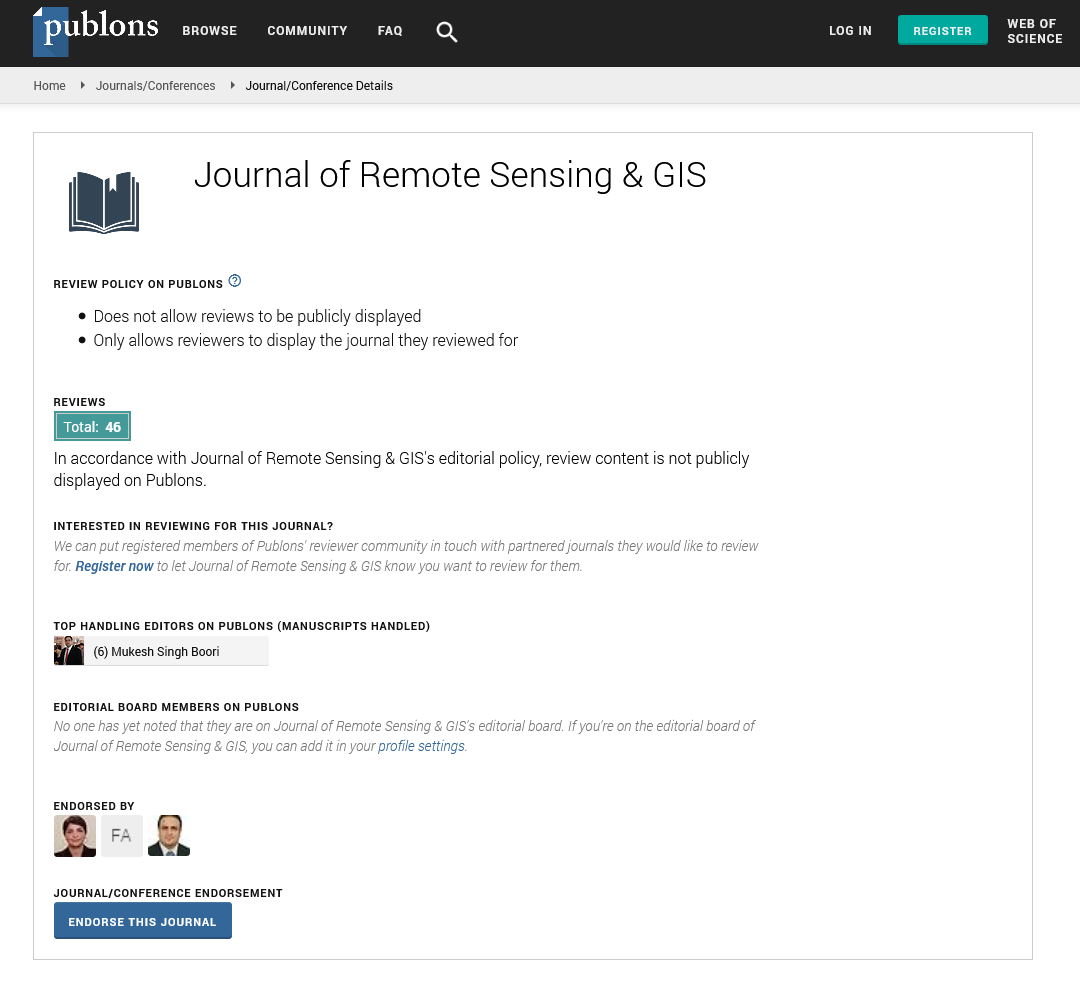Indexed In
- Open J Gate
- RefSeek
- Hamdard University
- EBSCO A-Z
- OCLC- WorldCat
- Publons
- International Scientific Indexing
- Euro Pub
- Google Scholar
Useful Links
Share This Page
Journal Flyer

Open Access Journals
- Agri and Aquaculture
- Biochemistry
- Bioinformatics & Systems Biology
- Business & Management
- Chemistry
- Clinical Sciences
- Engineering
- Food & Nutrition
- General Science
- Genetics & Molecular Biology
- Immunology & Microbiology
- Medical Sciences
- Neuroscience & Psychology
- Nursing & Health Care
- Pharmaceutical Sciences
Commentary - (2025) Volume 14, Issue 1
High-Resolution Earth Observation: Techniques and Applications of Remote Sensing Imagery in Resource Management
Liang Wein*Received: 25-Feb-2025, Manuscript No. JGRS-25-28685; Editor assigned: 27-Feb-2025, Pre QC No. JGRS-25-28685 (PQ); Reviewed: 14-Mar-2025, QC No. JGRS-25-28685; Revised: 21-Mar-2025, Manuscript No. JGRS-25-28685 (R); Published: 28-Mar-2025, DOI: 10.35248/2469-4134.25.14.371
Description
Remote sensing images have become a central tool in observing and understanding the earth’s surface. By capturing data from satellites, aircraft, or drones, remote sensing technologies allow for continuous and systematic monitoring of natural and human-made environments. These images support a wide range of applications, including land use classification, environmental change detection, agriculture, disaster assessment and urban development.
Unlike ground-based observations, remote sensing provides access to large and often inaccessible areas, offering frequent and repeatable data acquisition. Advances in sensor technology and image processing techniques have significantly increased the quality, resolution and analytical potential of remote sensing data.
Types of remote sensing images
Remote sensing images can be categorized based on the nature of sensors and the spectral, spatial, temporal and radiometric characteristics of the data collected.
Spectral resolution: Spectral resolution refers to the sensor’s ability to distinguish between different wavelengths of light. Multispectral images, such as those from Landsat satellites, typically contain several broad bands in the visible and nearinfrared regions. Hyperspectral images, like those from the Hyperion sensor, consist of hundreds of narrow bands and are used for detailed material identification.
Spatial resolution: This refers to the size of the smallest object that can be detected in an image. High-resolution images, such as those from commercial satellites like WorldView or QuickBird, can capture objects as small as 30 centimeters. Medium and coarse resolutions are more suitable for regional or global studies.
Temporal resolution: Temporal resolution indicates how frequently a sensor revisits the same location. Sensors with high temporal resolution are important for monitoring dynamic phenomena like crop growth, flooding, or urban expansion.
Radiometric resolution: This relates to the sensitivity of a sensor to detect slight differences in energy. Higher radiometric resolution allows for more precise detection of surface features and subtle changes.
Image acquisition platforms
Remote sensing images are acquired from various platforms:
Satellites: These provide wide-area coverage and are suitable for long-term monitoring. They are often used in meteorology, climate studies, agriculture and forestry.
Aircraft: Airborne sensors offer flexibility in image acquisition and can collect higher-resolution data at lower altitudes. They are used for detailed mapping and targeted environmental assessments.
Unmanned Aerial Vehicles (UAVs): UAVs or drones are increasingly used for remote sensing, offering low-cost, highfrequency data collection for small-scale studies. They are particularly useful for precision agriculture, conservation and infrastructure inspection.
Image processing and analysis
The raw data collected from remote sensing platforms must undergo a series of processing steps to become useful for interpretation. These steps include:
Radiometric and geometric correction: Adjustments are made to correct sensor noise, atmospheric distortions and geometric misalignments to ensure accurate spatial representation.
Image classification: This process involves categorizing image pixels into land cover classes such as vegetation, water, soil, or built-up areas. Classification techniques may be supervised, where training data guide the classification, or unsupervised, where patterns are identified automatically.
Change detection: Multi-temporal images are compared to identify changes in land cover or land use over time. This is essential for tracking deforestation, urbanization, or the impacts of natural disasters.
Vegetation indices: Indices like the Normalized Difference Vegetation Index (NDVI) are derived from multispectral images and used to assess vegetation health and density.
Applications of remote sensing images
Remote sensing images serve a wide array of scientific, governmental and commercial purposes. Their applications are diverse and continue to expand with advances in technology.
Agriculture: Satellite and drone imagery support crop monitoring, yield estimation and irrigation planning. By detecting plant stress, disease and nutrient deficiency, remote sensing helps optimize farm management.
Forestry: Forest cover mapping, biomass estimation and illegal logging detection rely on remote sensing data. Time-series images allow tracking of forest dynamics over decades.
Urban planning: Urban expansion, land use changes and infrastructure development can be mapped using highresolution imagery. These images aid in spatial planning and zoning regulations.
Disaster management: Remote sensing images are essential for assessing the extent of natural disasters like floods, earthquakes, wildfires and hurricanes. They enable rapid response planning and damage assessment without the need for on-site surveys.
Water resources: Monitoring of surface water bodies, watershed management and flood forecasting are supported by remote sensing. Thermal and radar images can be used to detect changes in water temperature or flow patterns.
Climate and environmental studies: Long-term datasets from satellites are invaluable for studying climate change, glacier retreat, desertification and sea-level rise. These data help researchers understand global patterns and predict future scenarios.
Challenges and limitations
Despite their usefulness, remote sensing images come with certain limitations. Cloud cover can obstruct optical sensors, especially in tropical and coastal regions. Data from multiple sensors often require harmonization due to differences in resolution and calibration. Moreover, image interpretation may be affected by atmospheric interference, sensor limitations, or landscape complexity.
The cost and availability of high-resolution commercial images can also pose constraints for researchers in certain regions or sectors.
Conclusion
Remote sensing images have transformed how we observe and analyze the earth’s surface. They provide a non-intrusive, largescale means of collecting spatial data across time and geography. From supporting agriculture to managing natural disasters, remote sensing continues to expand its role in decision-making, planning and research. As sensor technologies and data processing methods evolve, the precision and scope of remote sensing applications are likely to grow, offering new ways to monitor and manage our planet’s resources.
Citation: Wein L (2025) High-Resolution Earth Observation: Techniques and Applications of Remote Sensing Imagery in Resource Management. J Remote Sens GIS.14:371.
Copyright: © 2025 Wein L. This is an open-access article distributed under the terms of the Creative Commons Attribution License, which permits unrestricted use, distribution and reproduction in any medium, provided the original author and source are credited.

